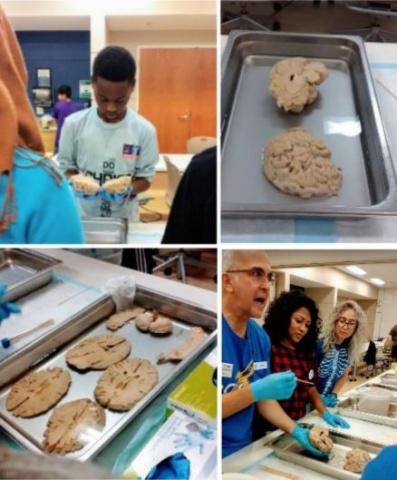
Curious middle schoolers got up close and personal with the human brain in the Trent Semans Center this June, thanks to the Building Opportunities and Overtures in Science and Technology (BOOST) program and the Neurology Department’s Leonard White, PhD.
BOOST is a recurring week-long program that teaches middle school students, specifically minorities, girls, and children from low-income backgrounds, to inspire them to seek careers in science, technology, engineering (STEM), medicine, and related fields. BOOST students recently spent a week at Duke learning about the brain and engaging in other learning opportunities such as pollution in Durham, different types of snakes, nutrition and the amount of energy in a hamburger, and about medicinal properties.
In their brain-based lesson, students asked a wide range of questions about the size of the male and female brain, whether brain size determines determines person’s IQ, how and if sheep develop Alzheimer’s, if one’s memory can be restored, and the effects of spinal injuries on the brain, and other topics.
“I learned about the difference in brain chemistry for those that have psychological illnesses,” 10th grade Junior Coach in-training, Mackenzie Giattino said after the first segment was over.
Students were directed to stations in the room where they could view and touch brain samples from deceased patients that were diagnosed with a brain illness. The brain samples displayed were held in cerebrospinal fluid, or brain fluid. Students learned how the wiring and shape of the brain determined whether the patient was left handed or right handed, and possible brain illnesses that patient may have suffered from.
“There are two different ways that pain is sent into the nervous system,” said White as he explained the nervous system. “There's something called fast pain. That’s what might help pull your feet back when you stub your toe. Then there's pain that actually makes you feel like ‘all man, I stubbed my toe, it really hurts,’ and you start getting sad. That’s what we call slow pain or secondary pain. Both of those will slow down as we age.”
There were eighteen brain samples available for students to observe and touch in the laboratory. Several students put on gloves and held one of the samples in their hands while others inspected the brain with a thin wooden stick. White and Undergraduate Neuroscience major Cindy Clements pointed out the right and left hemispheres of the brain, along with other parts of the muscle and explained how each part is crucial to our daily lives.
“The front part of the brain that sits right above the eye is what we would normally use to say, ‘this is not a good idea or I understand this is going to make someone else feel pain or feel bad so I’m not going to do that.’” White explained. “That’s the part of the brain that helps us control those kind of impulses that one may have. If that part of the brain is not wired well, if it's not functioning well, or if it’s injured, we may not even have that thought in our head where we’re able to process that.”
Read more about BOOST, or learn how to donate or volunteer, here.